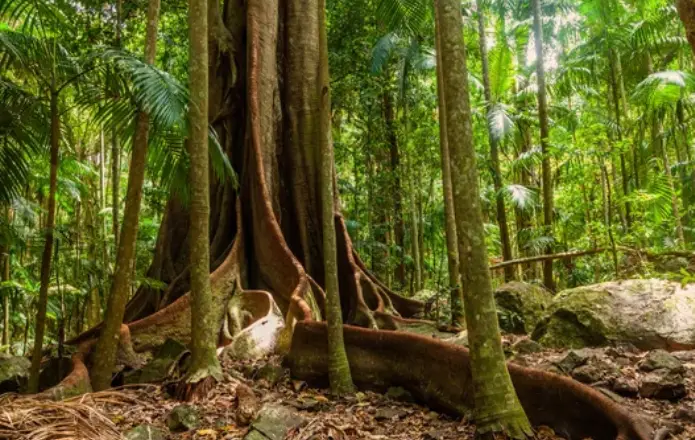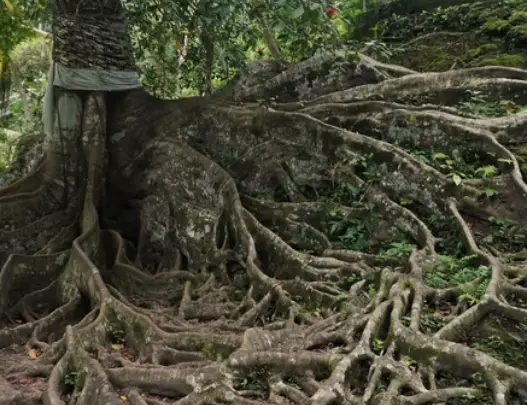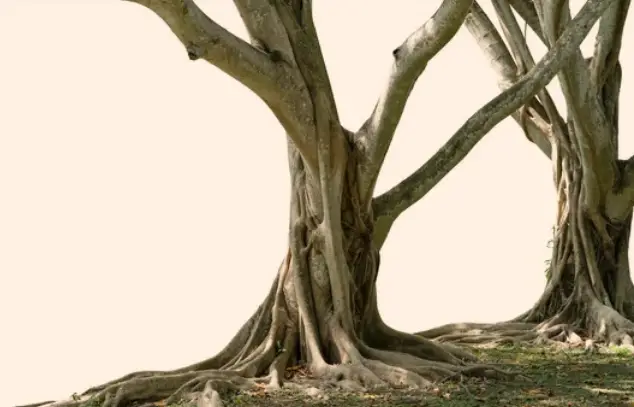Tree with Longest Roots: Discovering the Extent of Its Root System
Trees are an essential part of our ecosystem, providing oxygen, shade, and habitat for a variety of animals. While we often admire trees for their towering height and lush foliage, their root systems are just as impressive. Some trees have roots that extend deep into the earth, allowing them to access nutrients and water that other plants can’t reach.
The depth and length of a tree’s roots depend on a variety of factors, including soil type, climate, and species. Some trees, like the wild fig tree in South Africa, have roots that extend up to 400 feet deep, making them one of the deepest-rooted trees in the world. Other trees, like the white oak and hickory, develop deep taproots during their early years to ensure they have a strong foundation for growth.
Understanding the root systems of trees is important for a variety of reasons. For example, it can help us better understand how trees absorb nutrients and water, and how they respond to changes in their environment. It can also help us make informed decisions about where to plant trees, and how to care for them to ensure they continue to thrive.
Tree Roots

Tree roots play a crucial role in the survival and growth of trees. They anchor the tree to the ground, absorb water and nutrients, and provide structural support. Here are some key things to understand about tree roots:
- Roots grow in search of resources: Roots grow outward and downward, seeking water, nutrients, and oxygen. This means they often extend far beyond the tree’s drip line (the area under the outermost branches).
- Roots can be divided into two types: primary and secondary. Primary roots are the main structural roots that anchor the tree and provide support. Secondary roots are smaller roots that branch off from the primary roots and absorb water and nutrients.
- The depth and spread of tree roots depend on several factors, including soil type, moisture content, and available nutrients. In general, trees that grow in dry or nutrient-poor soils tend to have deeper and wider root systems than trees that grow in moist or nutrient-rich soils.
- Some trees have longer roots than others. For example, the taproot of a mature oak tree can extend up to 20 feet deep, while the roots of a mature poplar tree can extend up to 100 feet wide. However, the length and depth of tree roots can vary widely depending on the species, soil conditions, and other factors.
Understanding the anatomy and function of tree roots is essential for arborists, landscapers, and anyone who works with trees. By understanding how roots grow and function, professionals can make informed decisions about planting, pruning, and maintaining trees to ensure their long-term health and vitality.
The Longest Roots: An Overview

Trees are an essential part of the environment, providing numerous benefits for humans and animals. One of the most impressive aspects of trees is their root system, which allows them to absorb nutrients and water from deep within the ground. Some trees have roots that extend far deeper and wider than others, making them particularly impressive.
The Guinness World Record for the longest root belongs to a winter rye plant (Secale cereale), which produced 622.8 kilometers (386.9 miles) of roots in just 0.051 cubic meters (1.801 cubic feet) of earth. This is an incredible feat and demonstrates the extent to which some plants are capable of growing.
However, it is important to note that not all trees have roots that extend so far. The depth and spread of a tree’s roots depend on various factors, including the species, soil type, and climate. For example, trees planted closely together will generally have a less extensive root system than open-grown trees.
Despite this, some trees are known for having particularly deep and extensive roots. The Bristlecone pine, for example, is a species that is known for its longevity and ability to survive in harsh environments. Some specimens have been found to have roots that extend up to 50 meters (164 feet) deep in search of water.
Another tree with impressive roots is the Coast Redwood, which can grow up to 115 meters (380 feet) tall and have roots that extend up to 60 meters (197 feet) deep. These roots help the tree to access water from deep within the ground and provide stability against strong winds.
Overall, the length and extent of a tree’s roots depend on various factors, and some trees are particularly impressive in this regard. While the winter rye plant holds the Guinness World Record for the longest root, there are many other trees with deep and extensive root systems that are worth exploring.
Species with the Longest Roots
When it comes to trees with the longest roots, there are several species that stand out. These trees have adapted to various soil conditions and can grow roots that extend deep into the ground to access water and nutrients. Here are some of the most impressive species:
Fig Trees
Fig trees are known for their extensive root systems, which can reach depths of up to 400 feet. One species, in particular, the wild fig tree (Ficus sycomorus), has roots that go as deep as 122 meters (400 feet) in the Transvaal region of South Africa, making it one of the deepest-rooted trees in the world. Fig trees are also known for their ability to grow in rocky soils and arid climates, thanks to their deep roots.
Poplar Trees
Poplar trees are fast-growing trees that can reach heights of up to 100 feet. They are also known for their extensive root systems, which can extend up to 100 feet deep. These roots can help stabilize the soil and prevent erosion, making poplar trees a popular choice for reforestation and landscaping projects. Some species of poplar trees, such as the eastern cottonwood (Populus deltoides), can also grow in wet soils and floodplains, thanks to their deep roots.
Redwood Trees
Redwood trees are some of the tallest trees in the world, reaching heights of up to 379 feet. They are also known for their extensive root systems, which can extend up to 100 feet deep. These roots help anchor the tree in the ground and provide it with the water and nutrients it needs to grow. Redwood trees are also known for their ability to grow in nutrient-poor soils, thanks to their deep roots and their ability to form symbiotic relationships with fungi that help them access nutrients.
In conclusion, these are just a few of the many tree species that have adapted to grow deep roots. Whether they are growing in rocky soils, arid climates, or wetlands, these trees have found ways to thrive and survive by growing roots that extend deep into the ground.
The Role of Long Roots in Ecosystem

Trees with long roots play a vital role in maintaining the health of ecosystems. They are able to access water and nutrients from deep within the soil, which can be beneficial for the tree itself as well as other plants in the surrounding area.
One of the most important functions of long roots is their ability to regulate water flow in ecosystems. Deep roots can access groundwater, which can help to maintain streamflow during dry periods. This is particularly important in areas that experience droughts or have a high demand for water.
Long roots also play a key role in soil carbon sequestration. As roots grow deeper into the soil, they can access carbon that has been stored underground. This carbon can then be used to build new plant tissue, which can help to reduce the amount of carbon in the atmosphere.
Furthermore, long roots can help to stabilize soil and prevent erosion. This is especially important in areas with steep slopes or loose soil that is prone to landslides.
Overall, trees with long roots are an important component of healthy ecosystems. They are able to access water and nutrients from deep within the soil, regulate water flow, sequester carbon, and prevent erosion.
Factors Influencing Root Length
Root length is a crucial factor in determining a tree’s ability to access nutrients and water from the soil. The length of a tree’s roots is influenced by several factors, including soil type, climate, and water availability.
Soil Type
The type of soil in which a tree is planted can significantly affect the length of its roots. Sandy soils, for example, tend to have lower water-holding capacity, which can result in shorter roots. In contrast, loamy soils with high organic matter content can promote root growth due to their better water and nutrient retention capacity.
Climate
Climate plays a vital role in determining the length of a tree’s roots. Trees growing in warm, humid climates tend to have longer roots than those growing in colder, drier regions. This is because warmer temperatures and higher humidity levels promote root growth and allow trees to access more water from the soil.
Water Availability
The availability of water is another critical factor that influences the length of a tree’s roots. Trees growing in areas with high rainfall or near water sources tend to have longer roots as they can access more water. In contrast, trees growing in arid regions with limited water availability may have shorter roots as they need to conserve water.
In conclusion, the length of a tree’s roots is influenced by several factors, including soil type, climate, and water availability. Understanding these factors is essential for tree growers and landscapers to select the right tree species for a particular location and to ensure optimal growth and development.
Implications of Long Roots for Tree Health
Trees with long roots have several advantages when it comes to their overall health. Here are some implications of long roots for tree health:
Increased Nutrient and Water Absorption
Long roots can extend deep into the soil, allowing trees to access more nutrients and water. This can help trees survive in dry or nutrient-poor soil conditions. In fact, some trees with long roots can even tap into underground water sources, such as aquifers, to sustain themselves during droughts.
Improved Stability
Trees with long roots are often more stable than those with shallow roots. This is because long roots can anchor a tree more firmly in the ground, preventing it from toppling over in high winds or storms. Additionally, long roots can help prevent soil erosion by holding the soil in place.
Greater Longevity
Trees with long roots tend to live longer than those with shallow roots. This is because long roots can help trees access more nutrients and water, which can help them resist diseases and pests. Additionally, long roots can help trees survive droughts and other environmental stressors that can shorten their lifespan.
Challenges
While trees with long roots have several advantages, they also face some challenges. For example, long roots can be more susceptible to damage from construction or other disturbances. Additionally, long roots can be difficult to prune or remove, making it more challenging to maintain or remove trees with long roots.
Overall, the implications of long roots for tree health are significant. Trees with long roots are often more resilient, stable, and long-lived than those with shallow roots. However, they also face some unique challenges that must be taken into account when managing or maintaining them.
Human Interaction with Long Root Trees
Trees with long roots have been revered and utilized by humans throughout history. In some cultures, long root trees are considered sacred and are protected from harm. In other cultures, they are used for their medicinal properties or as a source of food and building materials.
One example of a tree with long roots is the Banyan tree, which is native to India and has roots that can grow up to several meters long. In Hindu mythology, the Banyan tree is considered sacred and is believed to be the abode of the god Vishnu. The tree is also used in traditional medicine to treat a variety of ailments, including diarrhea and dysentery.
Another tree with long roots is the Baobab tree, which is native to Africa and can have roots that reach over 100 feet long. The Baobab tree has been used by African tribes for centuries as a source of food, water, and shelter. The tree’s leaves, fruit, and bark are all edible, and the hollow trunk can be used as a natural shelter.
In modern times, long root trees are often used for their ecological benefits. Trees with long roots can help prevent soil erosion and can also help to filter pollutants from the soil and water. They are also important for carbon sequestration and can help to mitigate the effects of climate change.
Overall, trees with long roots have played an important role in human history and continue to be valued for their cultural, medicinal, and ecological significance.
Conclusion
In conclusion, trees with the longest roots are those that have adapted to their environment and have developed a deep and extensive root system to withstand harsh conditions. These trees have been able to survive for thousands of years, and some even longer.
The Great Basin bristlecone pine, Llangernyw Yew, and Alerce Milenario are some of the oldest trees in the world, and they have been able to survive for so long due to their deep root systems. The Pando tree, on the other hand, is the largest known aspen clone and spans over 106 acres.
It’s important to note that the length and depth of a tree’s roots depend on various factors, including soil type, moisture level, and the tree’s species. While some trees may have deep roots, others may have shallow roots that spread out horizontally.
Overall, trees with the longest roots are fascinating and have unique characteristics that make them stand out from other trees. They play an essential role in the ecosystem and provide numerous benefits, including soil stabilization, erosion control, and carbon sequestration.
Frequently Asked Questions
What are some examples of trees with deep root systems?
Trees with deep root systems include oak, pine, hickory, and walnut trees. These trees have long taproots that can grow deep into the soil and help anchor the tree in place.
Which trees have taproot systems?
Trees with taproot systems include oak, hickory, and walnut trees. These trees have a single, large root that grows straight down into the soil.
What is the significance of deep roots in trees?
Deep roots in trees are significant because they help the tree anchor in place, absorb nutrients and water from deep in the soil, and provide stability during strong winds and storms.
What are the benefits of trees with deep roots?
Trees with deep roots can help prevent soil erosion, improve soil stability, and provide a habitat for wildlife. They can also help reduce the risk of flooding by absorbing excess water from the soil.
How do trees with deep roots affect soil stability?
Trees with deep roots can help improve soil stability by creating channels for water to flow through, which can help prevent erosion. They can also help create a more porous soil structure, which can improve water infiltration and reduce the risk of soil compaction.
Can trees with deep roots prevent erosion?
Yes, trees with deep roots can help prevent erosion by anchoring the soil in place and absorbing excess water from the soil. They can also help create a more porous soil structure, which can improve water infiltration and reduce the risk of soil compaction.








